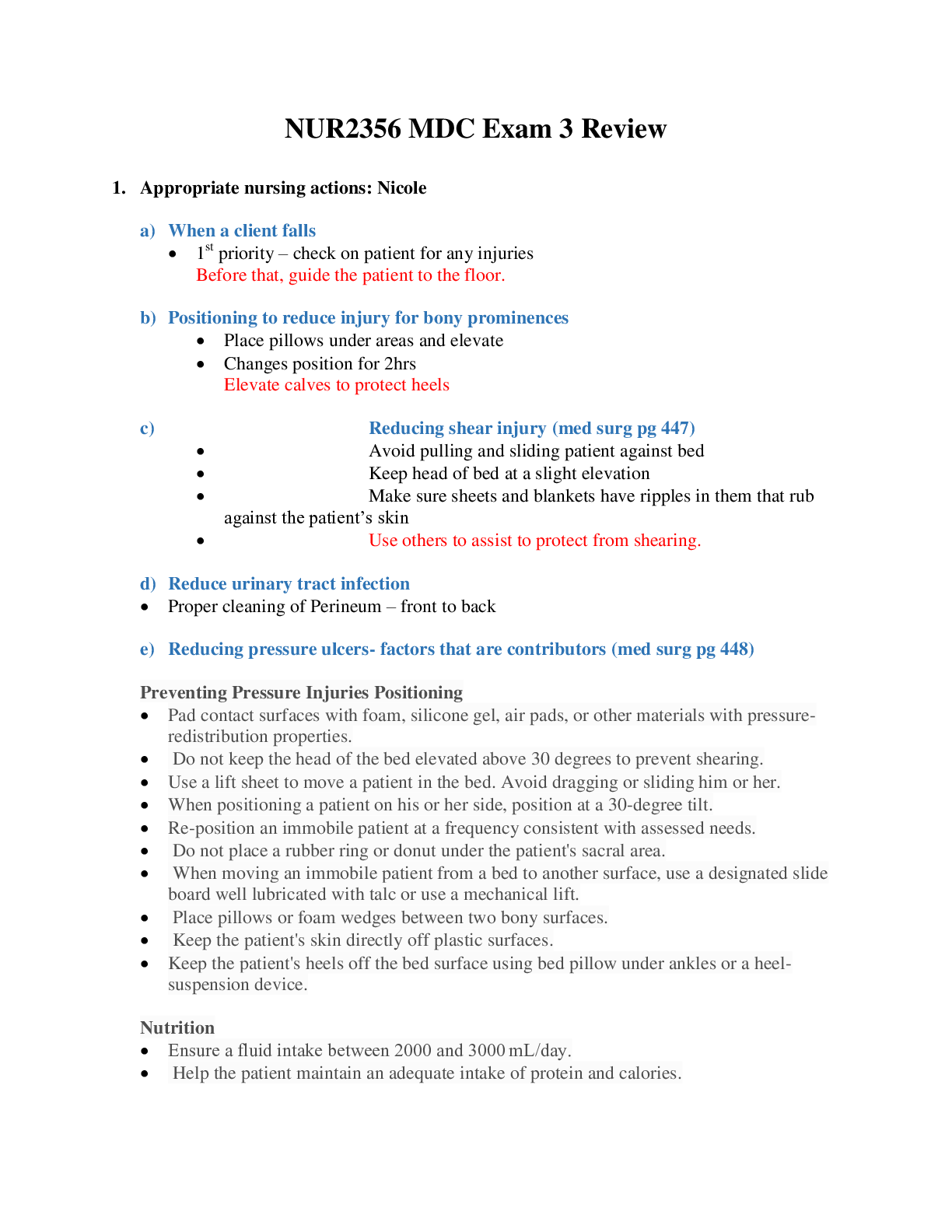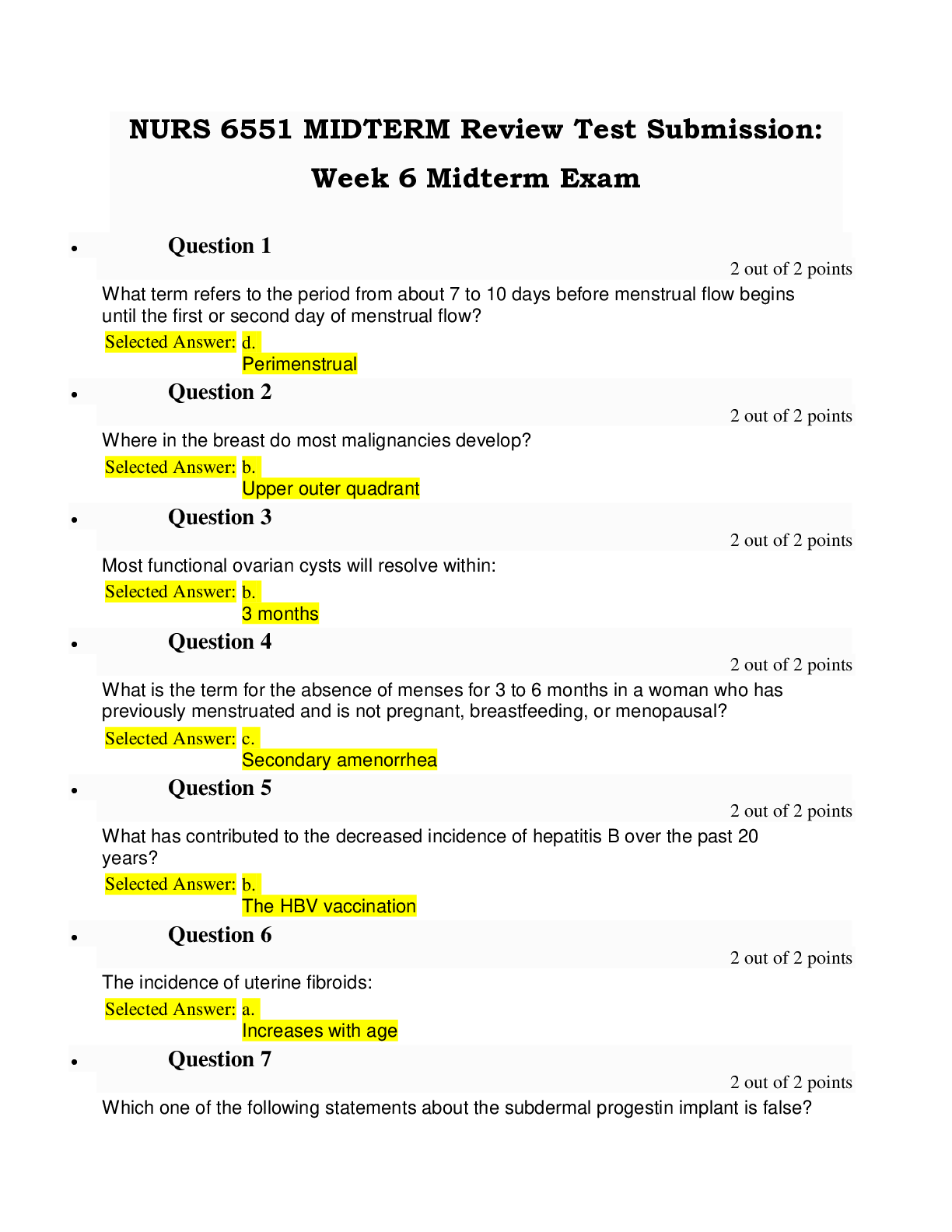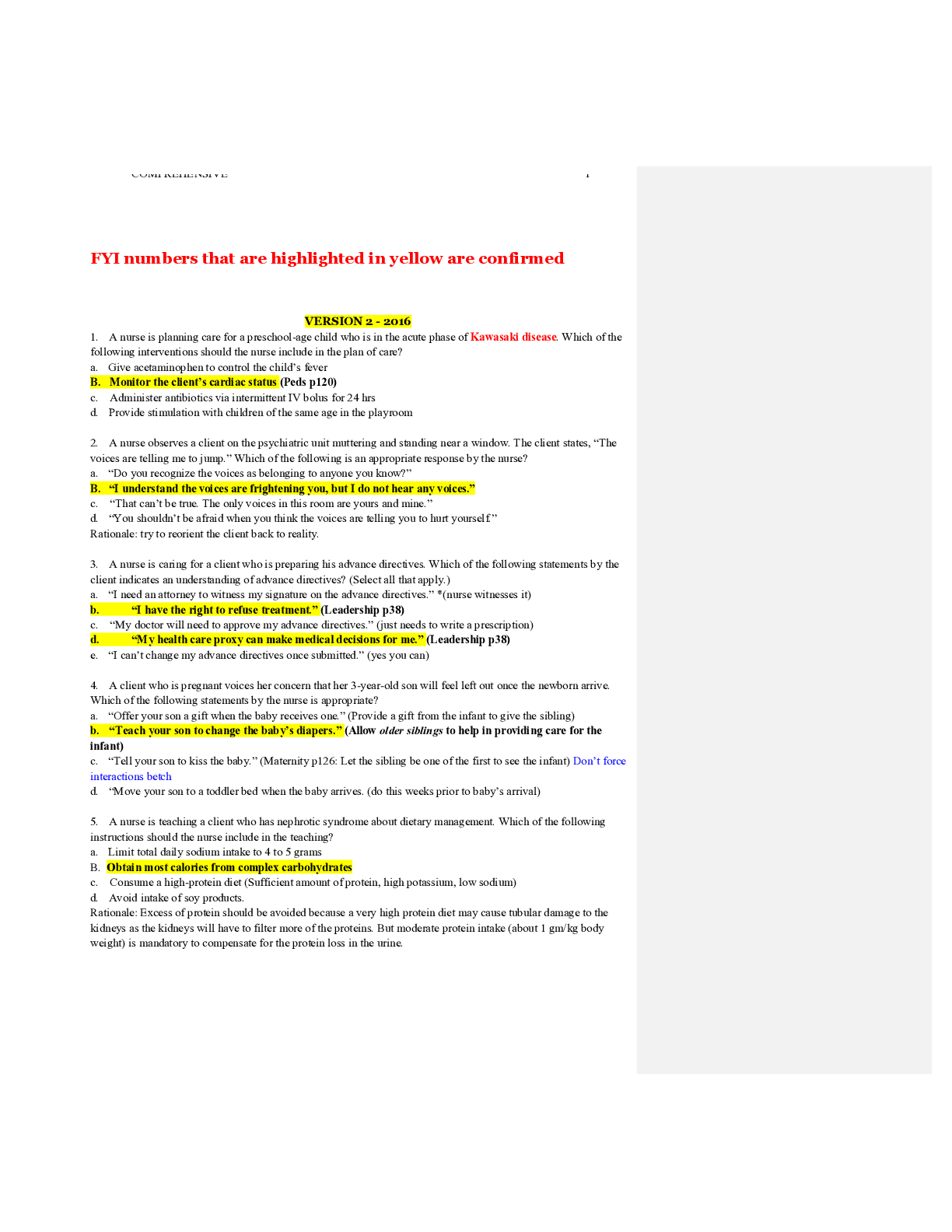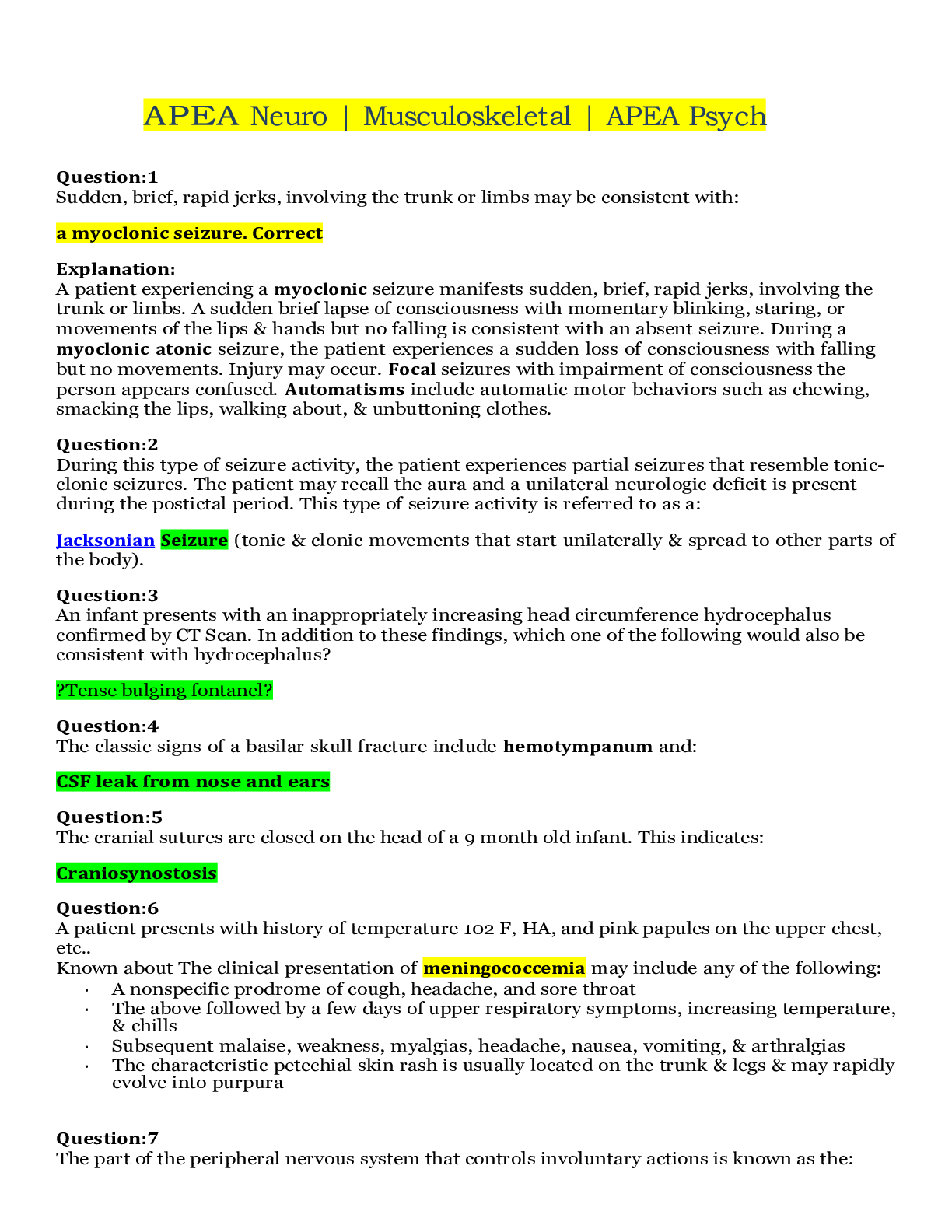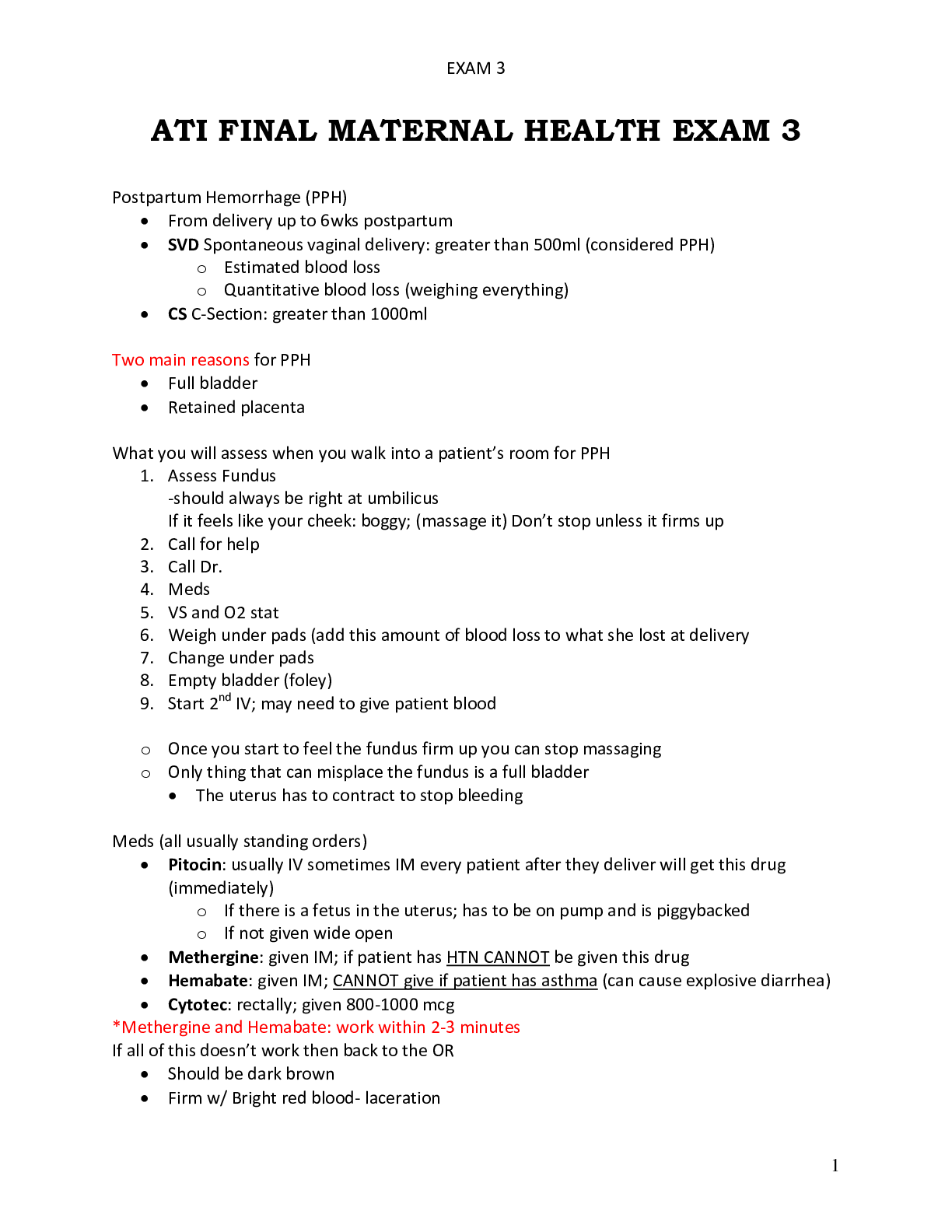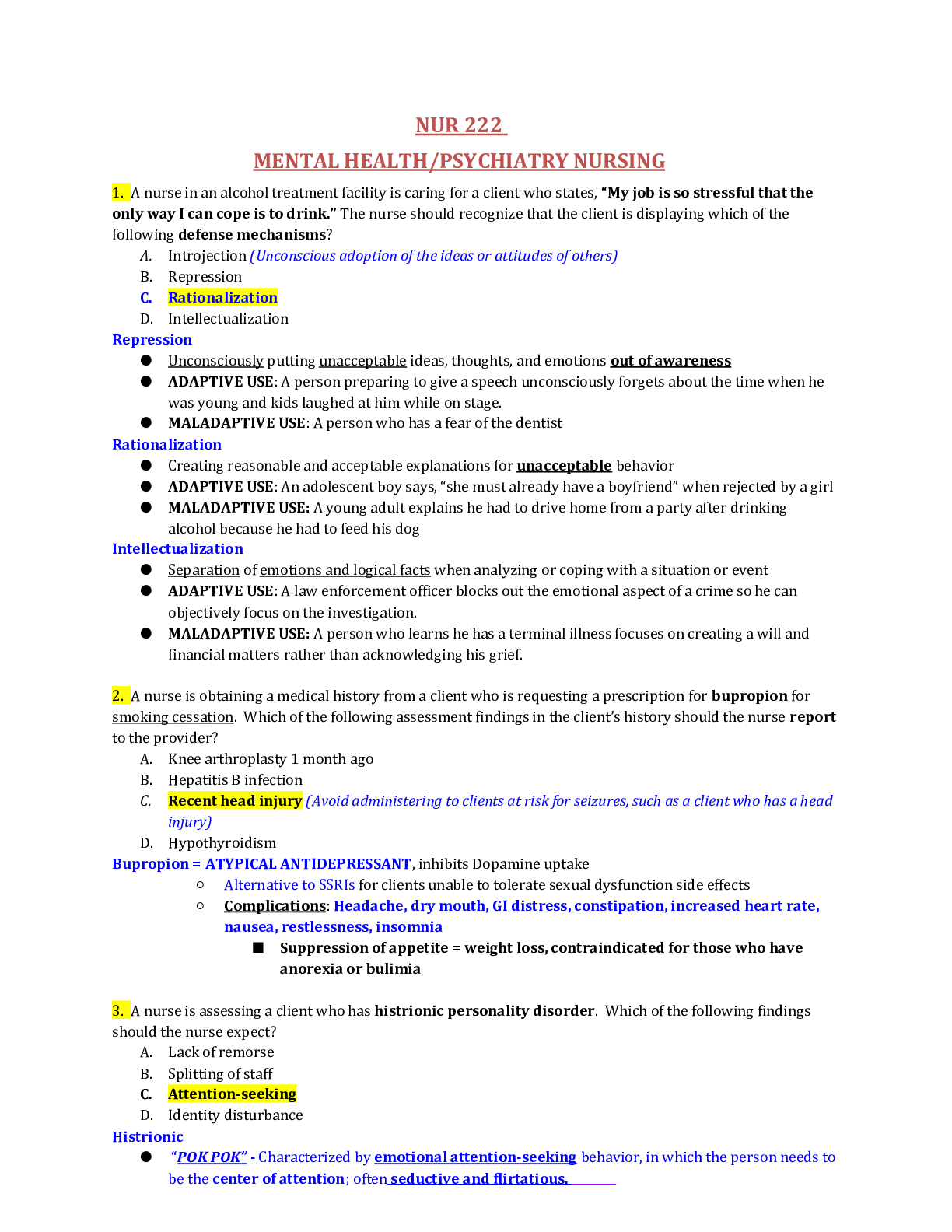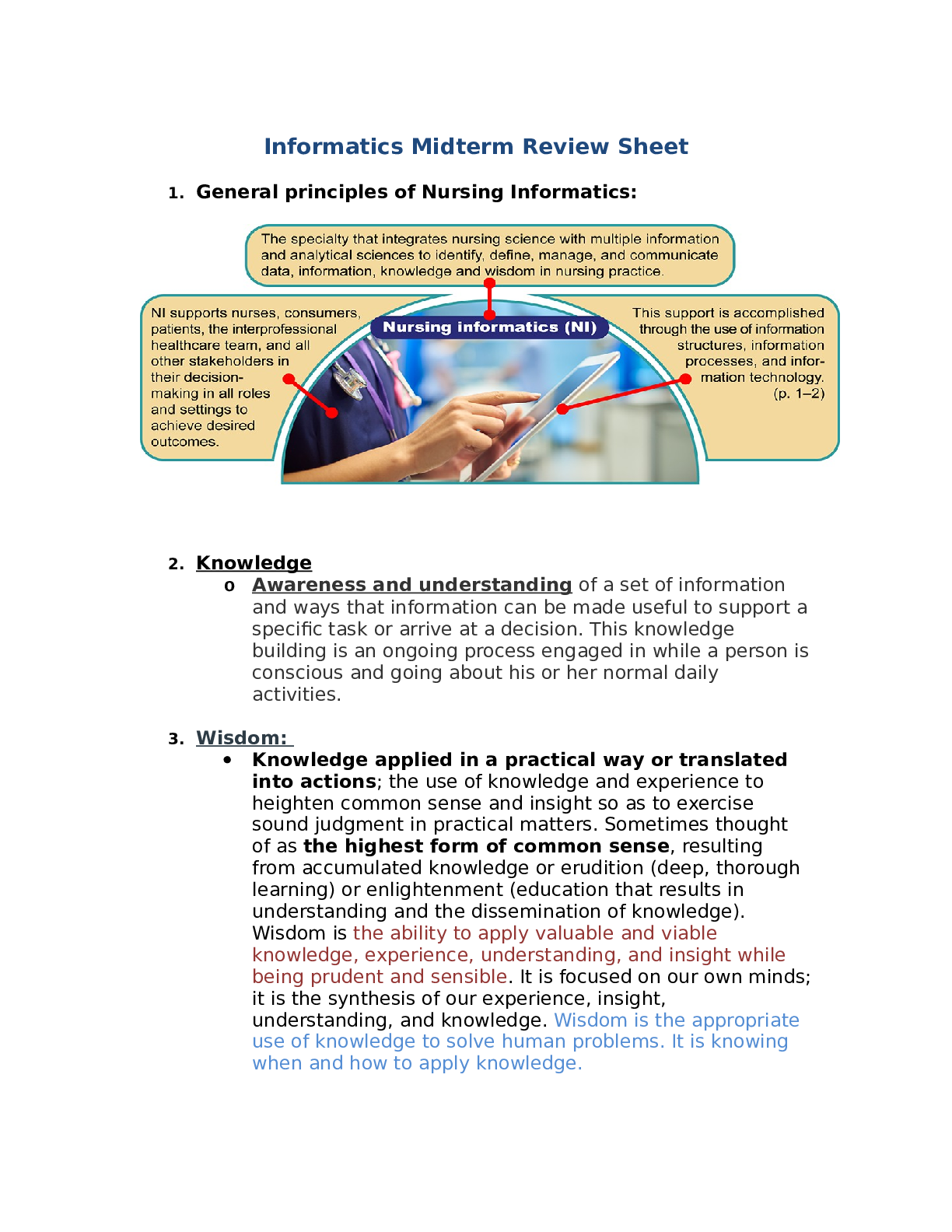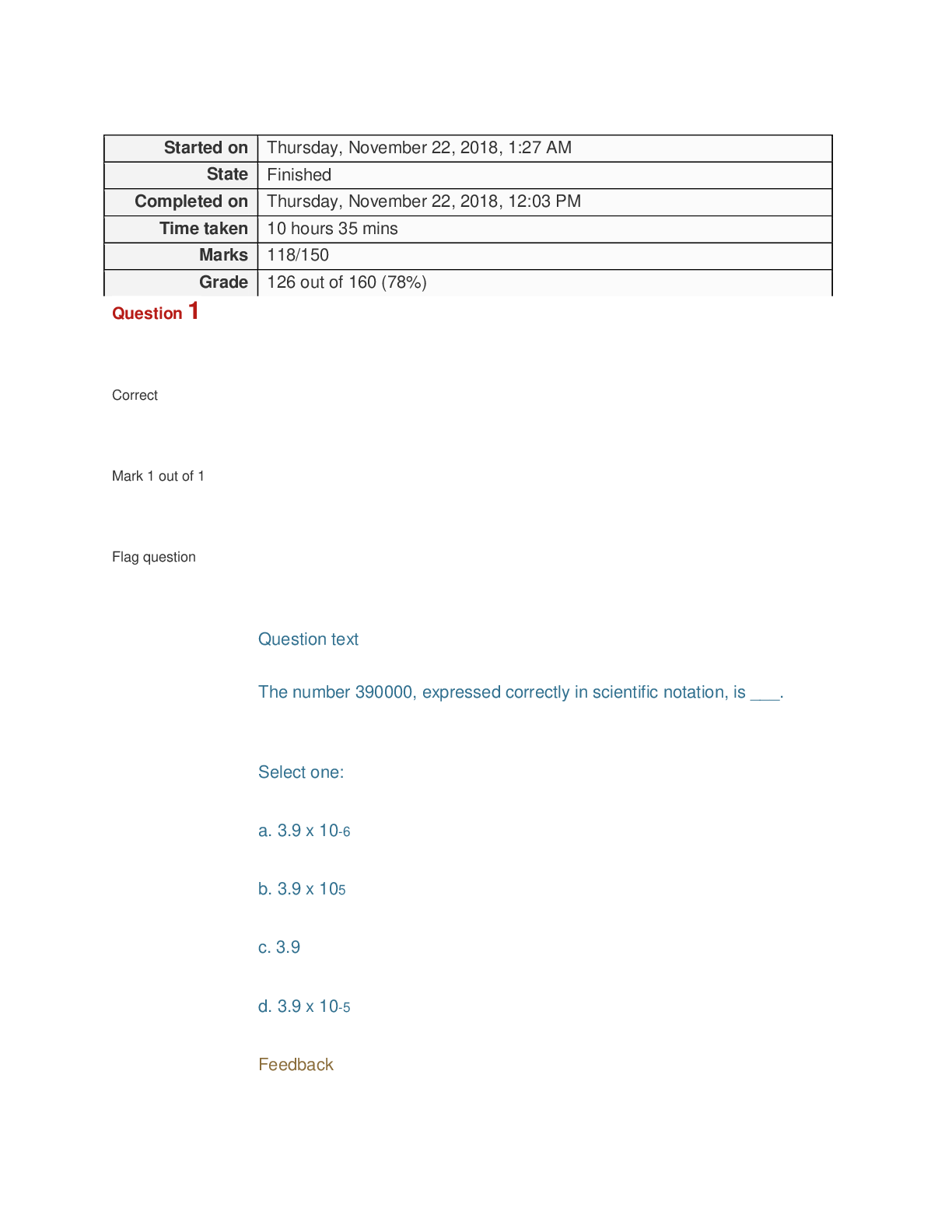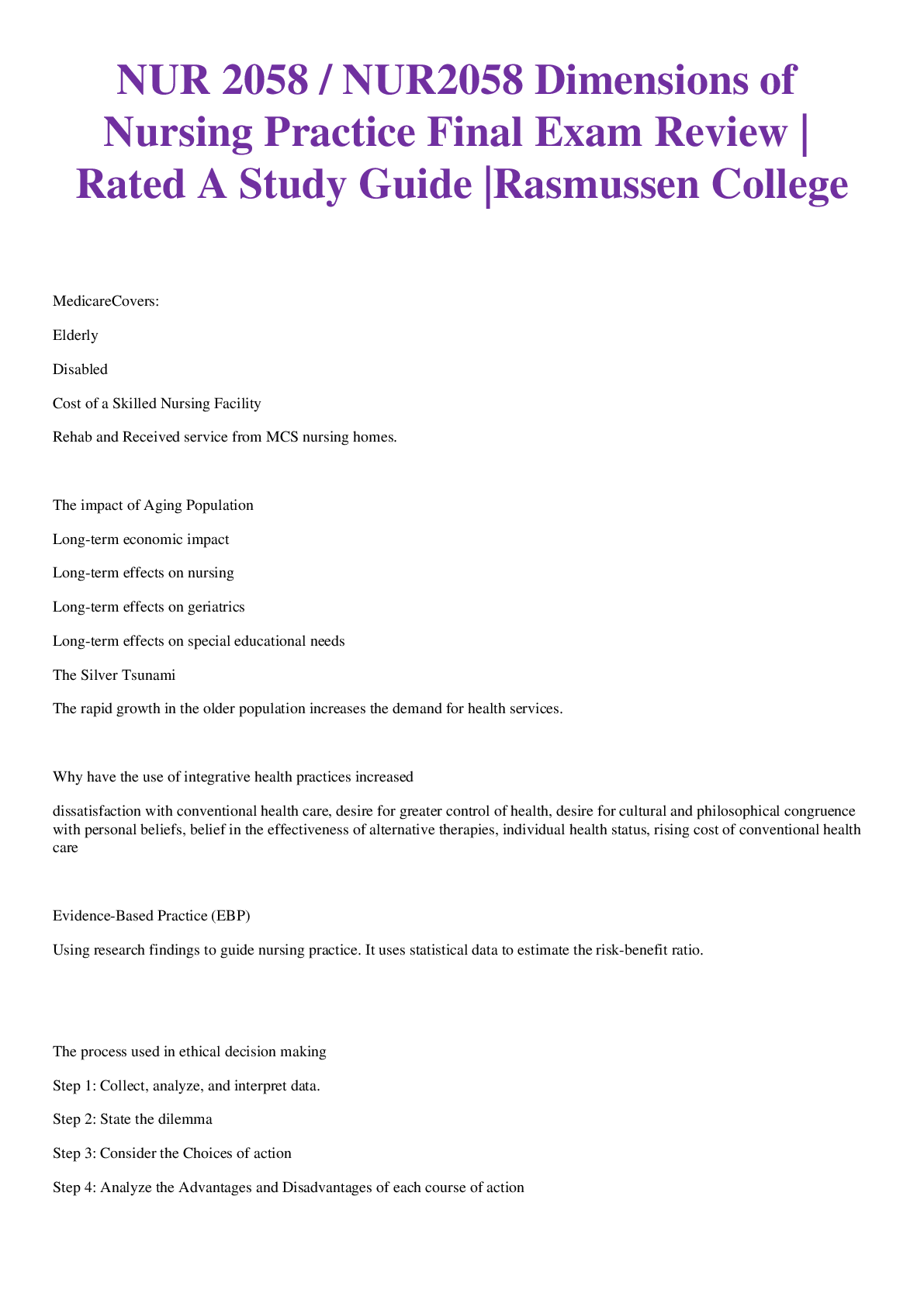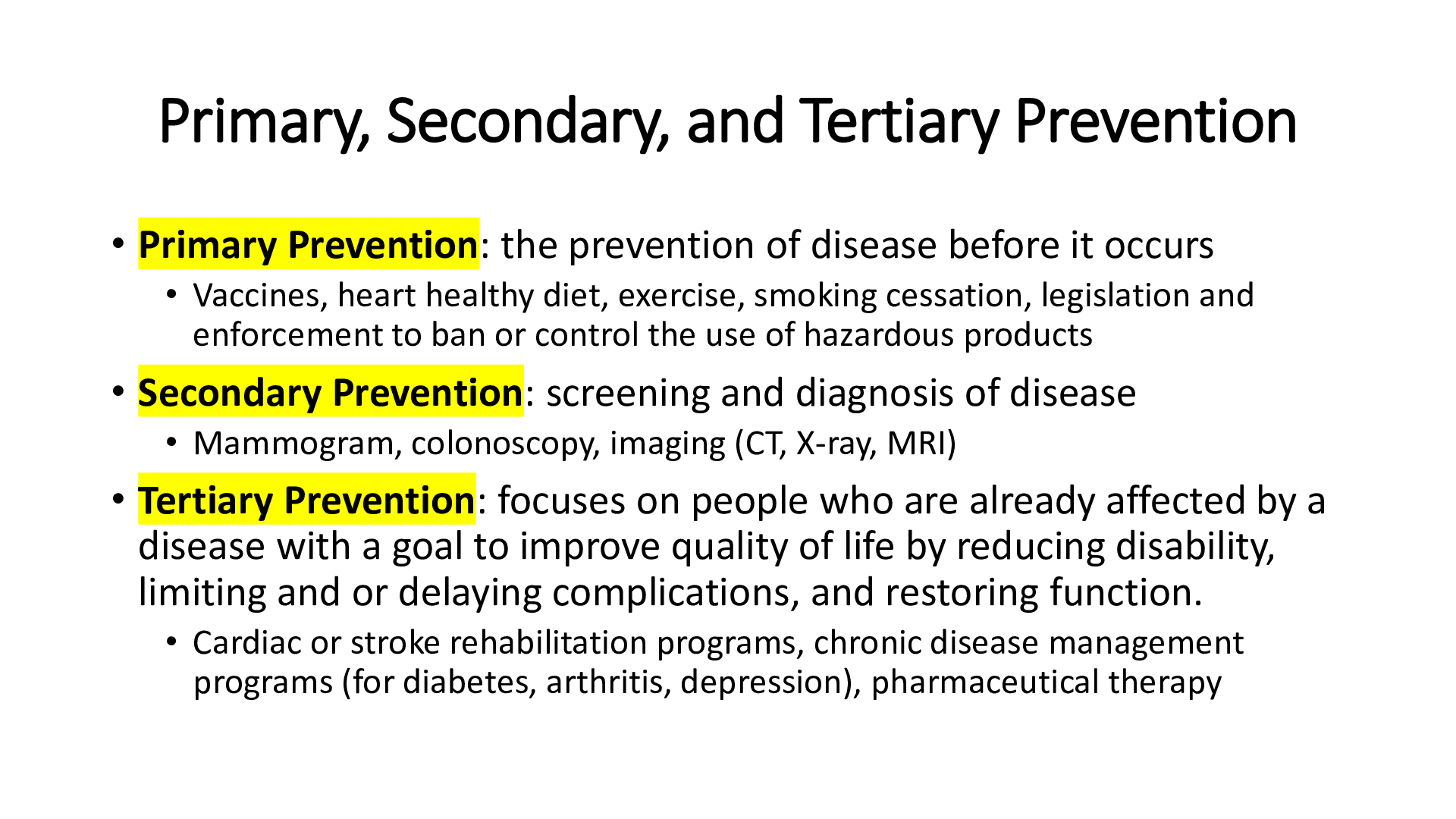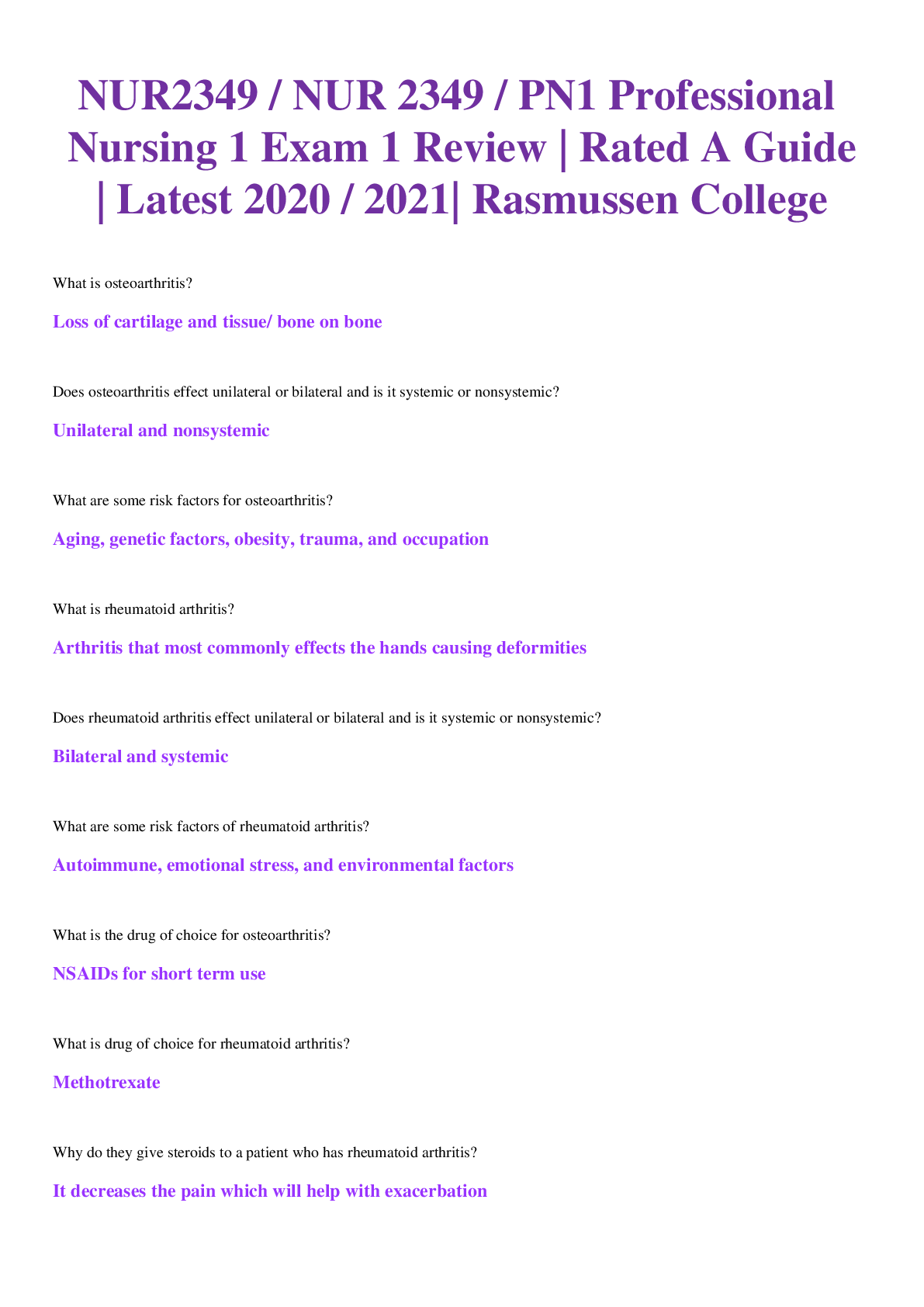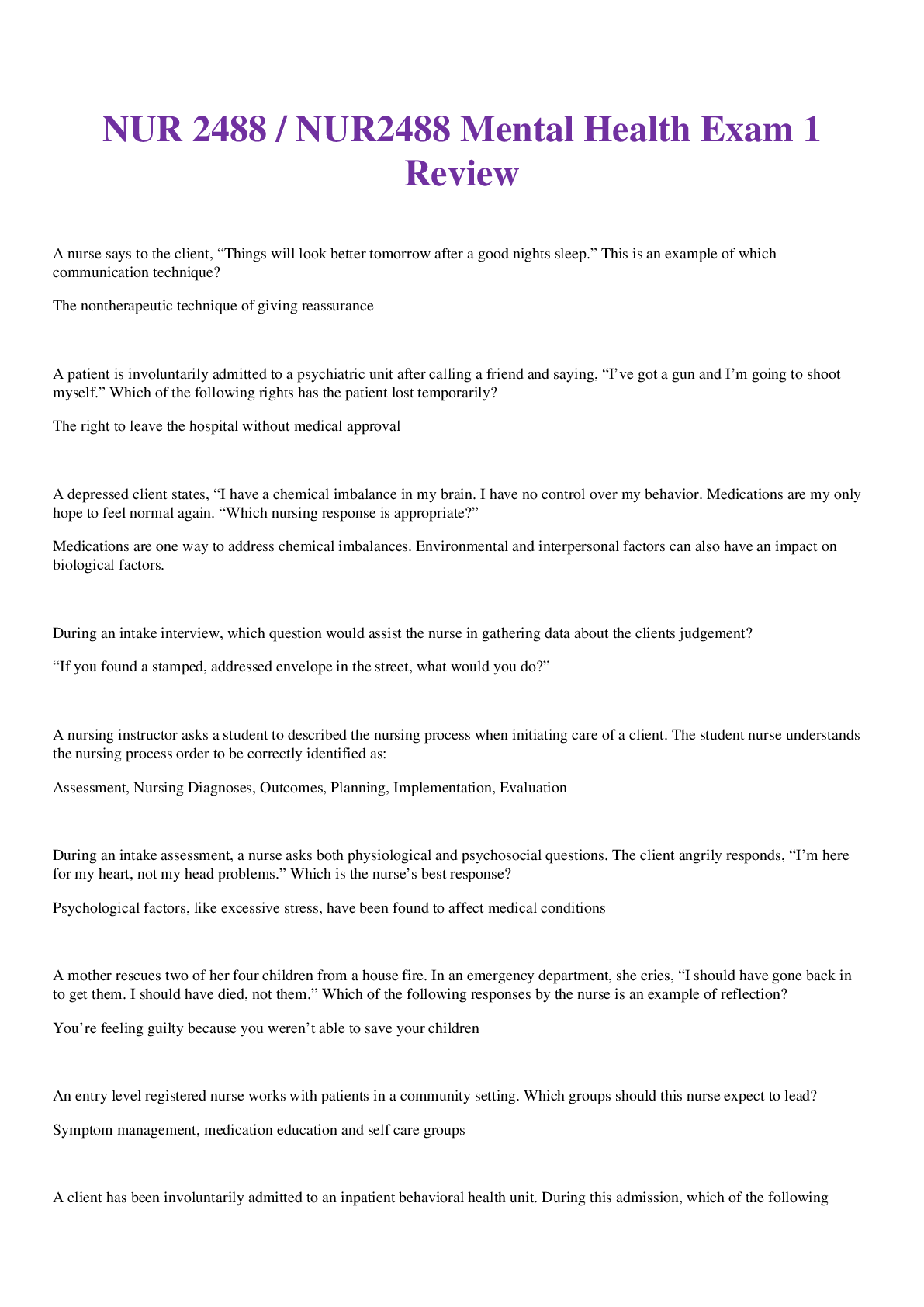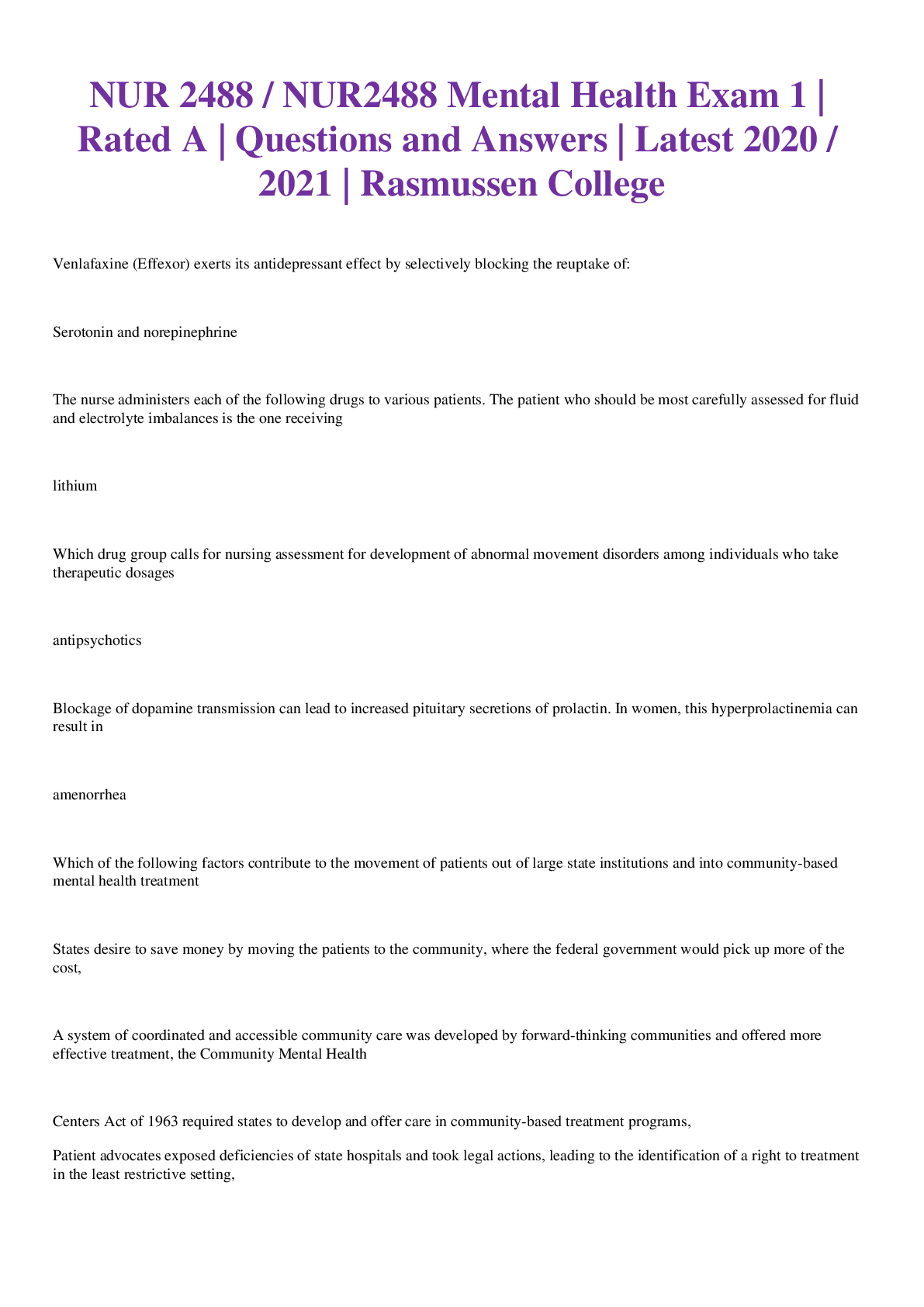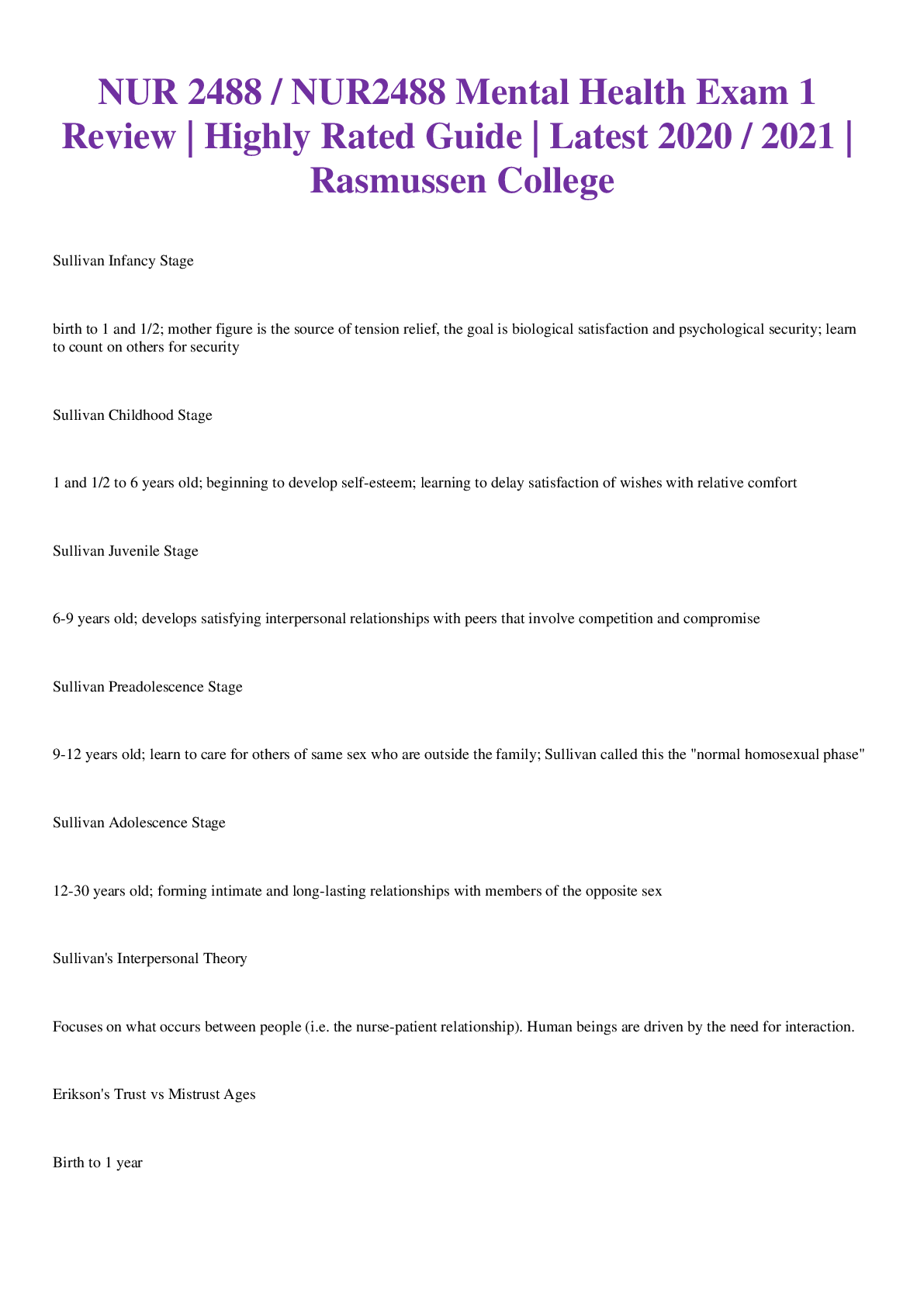Pharmacology > EXAM REVIEW > NURS 6521N Advanced Pharm week3 quiz- Graded A (All)
NURS 6521N Advanced Pharm week3 quiz- Graded A
Document Content and Description Below
NURS 6521N AdvancedPharm_week3_quizNURS 6521N AdvancedPharm_week3_quiz Question 1 1 out of 1 points A 58-year-old man is admitted to the emergency department. A diagnosis of severe digoxin t... oxicity is made. Bradycardia is present, and an electrocardiogram (ECG) confirms toxicity. The nurse will administer which of the following drugs? Response Feedback: Digoxin immune fab is used as the antidote to digoxin toxicity. The other drugs would not be used to treat digoxin toxicity. The patient could be taking furosemide as part of his drug regimen for heart failure. Question 2 1 out of 1 points A 70-year-old woman with a history of atrial fibrillation takes digoxin and verapamil to control her health problem. Verapamil achieves a therapeutic effect by Response Feedback: Verapamil acts by inhibiting the movement of calcium ions across the cardiac and arterial muscle cell membrane. It works preferentially in “slow response” myocardial tissue, such as the SA and AV nodes. Beta blockers inhibit adrenergic receptors and Class IB antiarrhythmics are among the drugs that decrease sodium and potassium conduction. Lidocaine weakens phase 4 diastolic depolarization and decreases the action potential duration and the effective refractory period of Purkinje fibers and ventricular muscle. Question 3 1 out of 1 points A nurse is caring for a patient with chronic angina. The patient is receiving ranolazine (Ranexa) 500 mg PO bid. Which of the following signs or symptoms would the nurse attribute to being a common adverse effect of this medication? Response Feedback: The most common adverse effects from ranolazine are dizziness, headache, constipation (not diarrhea), and nausea. Bradycardia is not an identified adverse effect of ranolazine therapy. Perspiring skin that is cold to the touch is a manifestation usually associated with a nitroglycerin overdose. Question 4 1 out of 1 points A nurse is providing patient education to a 35-year-old man who has been prescribed clonidine (Catapres) as part of step 2 antihypertensive therapy. The nurse shouldanticipate that the drug will be administered Response Feedback: Clonidine may be administered orally or parenterally but is most frequently administered transdermally. Question 5 1 out of 1 points A nurse is caring for a patient who is taking digoxin and a loop diuretic. Which of the following would be most important for the nurse to monitor? Response Feedback: Although it is important to monitor the patient's ECG, it is more important to closely monitor potassium levels when the patient is taking a drug that promotes the loss of potassium, such as thiazide or loop diuretics. Hypokalemia increases the effect of digoxin and increases the risk for digoxin toxicity. The patient's sodium levels and liver enzyme levels may need to be monitored periodically, but not as closely as potassium levels. Question 6 1 out of 1 points A female patient is taking 0.125 mg of digoxin daily for heart failure. At a recent clinic visit she reports that since she has been on the drug, she can breathe better and her heart rate has been around 74 beats per minute. The nurse weighs the patient and notices that she has gained 10 pounds since the digoxin therapy was started. The patient is concerned that the additional weight will necessitate an increase in the medication. Which of the following is an appropriate response by the nurse? Response Feedback: Serum digoxin levels are not affected significantly by changes in fat tissue weight and are best calculated on ideal body weight rather than actual weight of the patient. Therefore, the nurse will advise the patient that the dosage will not be changed. The nurse should know this, and there should be no need to ask the prescriber. Question 7 0 out of 1 points A patient is brought to the emergency department in hypertensive crisis. Nitroprusside is administered intravenously. The patient experiences diaphoresis and dizziness. Which of the following is the appropriate action by the nurse? Response Feedback: Administering nitroprusside too quickly can result in abdominal pain, apprehension, diaphoresis, dizziness, headache, muscle twitching, nausea, palpitations, restlessness, retching, and retrosternal discomfort. The nurse should quickly inform the prescriber and slow the infusion. Symptoms quickly subside when the nitroprusside infusion is slowed or stopped, and usually do not return when the infusion resumes at a slower rate. Consulting the prescriber for a dosechange would not help; the rate of drug administration is the issue. Continuing to give the nitroprusside at the ordered rate could be fatal. Question 8 1 out of 1 points A patient has recently been prescribed a drug that treats his hypertension by blocking the sympathetic receptors in his sympathetic nervous system. This action is characteristic of Response Feedback: Those drugs that stimulate sympathetic receptors are referred to as adrenergic or dopaminergic agonists (stimulators) and those that block are referred to as adrenergic antagonists (blockers). Adrenergic antagonism is not synonymous with the action of a cardiotonic drug. Question 9 1 out of 1 points A nurse is responsible for patient education for a 48-year-old woman who has been prescribed colestipol. The nurse will instruct the patient to take the medication Response Feedback: Colestipol is a bile acid sequestrant that promotes the oxidation of cholesterol to bile acids. Cholesterol is the major precursor to bile acids. Bile acids are secreted from the gallbladder and liver into the intestine during digestion. In the intestine, bile acids emulsify the fat and lipid particles from food, promoting absorption. Much of the bile acid that is secreted is reabsorbed and returned to the liver by hepatic circulation. Colestipol binds with the bile acids in the intestine to make them nonresorbable. The bile acids are then eliminated in the stool. Because of this mechanism of action, the drug should be administered before a meal. Question 10 1 out of 1 points A nurse is caring for a patient who is admitted into the cardiac care unit with acute, decompensated heart failure. Nesiritide (Natrecor) has been ordered. When preparing for administration of the drug, the nurse will Response Feedback: Nesiritide must be reconstituted and then further diluted for infusion. Reconstitute one vial by adding 5 mL of diluent that has been removed from a 250-mL plastic IV bag. Do not shake the vial. Rock the vial gently so that all surfaces, including the stopper, are in contact with the diluent. Add the entire contents of the reconstituted vial back to the 250-mL plastic IV bag and invert the bag several times to ensure complete mixing. Use the reconstituted nesiritide solution within 24 hours. The initial IV bolus must be drawn from the prepared infusion bag and administered over approximately 60 seconds through an IV port. Question 11 1 out of 1 points Which of the following patients is most likely to benefit from the administration of an adrenergic agonist? Response Feedback: One of the most frequent indications for adrenergic agonist drugs is shock. Their use is contraindicated in labor, and they would exacerbate hypertension. Question 12 1 out of 1 points A nurse explains to a patient that nitroglycerin patches should be applied in the morning and removed in the evening. This medication schedule reduces the potential for Response Feedback: The nurse will stress that it is important to remove the patch for 10 to 12 hours every 24 hours to prevent nitrate tolerance from developing. If anginal symptoms develop at night, the use of a beta blocker or calcium channel blocker should be considered. Patients who normally have angina only during daytime hours are not at substantial risk for developing nighttime angina with a nightly nitrate-free period. Applying the nitroglycerin patch in the morning and removing it in the evening would not significantly limit the adverse effects from the drug. Dependency does not occur with nitroglycerin, and prescribed dosages should not cause toxic effects. Question 13 1 out of 1 points A nurse who provides care in a busy clinic is aware of the high incidence and prevalence of hyperlipidemia and the consequent need for antihyperlipidemics in many patients. Treatment of high cholesterol using statins would be contraindicated in which of the following patients? Response Feedback: Active liver disease is a contraindication to the use of statins. As well, heavy alcohol use increases the risk of liver dysfunction. Respiratory disease, recent surgery, and organic cognitive deficits do not preclude the use of statins for high cholesterol. Question 14 1 out of 1 points A patient has been prescribed lovastatin for a high cholesterol level. The nurse's teaching plan will include a basic explanation of how the drug produces its therapeutic effect. The nurse will explain that lovastatin lowers cholesterol levels because itResponse Feedback: Lovastatin belongs to a group of drugs classified as statins. These drugs work by inhibiting cholesterol synthesis in the liver. Fibric acid derivatives and bile-acid resins also decrease cholesterol levels but they work at different sites. Fibric acid derivatives work on lipoproteins and triglycerides to reduce cholesterol, and bile-acid resins work in the gastrointestinal tract and bind bile salts in the intestine. Lovastatin is not a hormone. comes, but they are not directly indicative of the therapeutic action of diuretics in the treatment of CHF. Question 25 1 out of 1 points A nurse has administered a medication to a patient with hypertension. The prescribed drug is supposed to decrease cardiac output. A decrease in cardiac output would most likely Response Feedback: A drug-induced decrease in cardiac output would cause a decrease in the amount of circulating blood sent through the kidneys. If a patient has normal kidney function, a decrease in cardiac output would not result in an increased serum creatinine level. Further, the decrease in cardiac output would not cause an increased synergistic effect of the drug, nor would it decrease drug absorption in the blood. Question 1 Question 4 1 out of 1 points A nurse is providing patient education to a 35-year-old man who has been prescribed clonidine (Catapres) as part of step 2 antihypertensive therapy. The nurse shouldanticipate that the drug will be administered Response Feedback: Clonidine may be administered orally or parenterally but is most frequently administered transdermally. Question 5 1 out of 1 points A nurse is caring for a patient who is taking digoxin and a loop diuretic. Which of the following would be most important for the nurse to monitor? Response Feedback: Although it is important to monitor the patient's ECG, it is more important to closely monitor potassium levels when the patient is taking a drug that promotes the loss of potassium, such as thiazide or loop diuretics. Hypokalemia increases the effect of digoxin and increases the risk for digoxin toxicity. The patient's sodium levels and liver enzyme levels may need to be monitored periodically, but not as closely as potassium levels. Question 6 1 out of 1 points A female patient is taking 0.125 mg of digoxin daily for heart failure. At a recent clinic visit she reports that since she has been on the drug, she can breathe better and her heart rate has been around 74 beats per minute. The nurse weighs the patient and notices that she has gained 10 pounds since the digoxin therapy was started. The patient is concerned that the additional weight will necessitate an increase in the medication. Which of the following is an appropriate response by the nurse? Response Feedback: Serum digoxin levels are not affected significantly by changes in fat tissue weight and are best calculated on ideal body weight rather than actual weight of the patient. Therefore, the nurse will advise the patient that the dosage will not be changed. The nurse should know this, and there should be no need to ask the prescriber. Question 7 0 out of 1 points A patient is brought to the emergency department in hypertensive crisis. Nitroprusside is administered intravenously. The patient experiences diaphoresis and dizziness. Which of the following is the appropriate action by the nurse? Response Feedback: Administering nitroprusside too quickly can result in abdominal pain, apprehension, diaphoresis, dizziness, headache, muscle twitching, nausea, palpitations, restlessness, retching, and retrosternal discomfort. The nurse should quickly inform the prescriber and slow the infusion. Symptoms quickly subside when the nitroprusside infusion is slowed or stopped, and usually do not return when the infusion resumes at a slower rate. Consulting the prescriber for a dosechange would not help; the rate of drug administration is the issue. Continuing to give the nitroprusside at the ordered rate could be fatal. Question 8 1 out of 1 points A patient has recently been prescribed a drug that treats his hypertension by blocking the sympathetic receptors in his sympathetic nervous system. This action is characteristic of Response Feedback: Those drugs that stimulate sympathetic receptors are referred to as adrenergic or dopaminergic agonists (stimulators) and those that block are referred to as adrenergic antagonists (blockers). Adrenergic antagonism is not synonymous with the action of a cardiotonic drug. Question 9 1 out of 1 points A nurse is responsible for patient education for a 48-year-old woman who has been prescribed colestipol. The nurse will instruct the patient to take the medication Response Feedback: Colestipol is a bile acid sequestrant that promotes the oxidation of cholesterol to bile acids. Cholesterol is the major precursor to bile acids. Bile acids are secreted from the gallbladder and liver into the intestine during digestion. In the intestine, bile acids emulsify the fat and lipid particles from food, promoting absorption. Much of the bile acid that is secreted is reabsorbed and returned to the liver by hepatic circulation. Colestipol binds with the bile acids in the intestine to make them nonresorbable. The bile acids are then eliminated in the stool. Because of this mechanism of action, the drug should be administered before a meal. Question 10 1 out of 1 points A nurse is caring for a patient who is admitted into the cardiac care unit with acute, decompensated heart failure. Nesiritide (Natrecor) has been ordered. When preparing for administration of the drug, the nurse will Response Feedback: Nesiritide must be reconstituted and then further diluted for infusion. Reconstitute one vial by adding 5 mL of diluent that has been removed from a 250-mL plastic IV bag. Do not shake the vial. Rock the vial gently so that all surfaces, including the stopper, are in contact with the diluent. Add the entire contents of the reconstituted vial back to the 250-mL plastic IV bag and invert the bag several times to ensure complete mixing. Use the reconstituted nesiritide solution within 24 hours. The initial IV bolus must be drawn from the prepared infusion bag and administered over approximately 60 seconds through an IV port. Question 11 1 out of 1 points Which of the following patients is most likely to benefit from the administration of an adrenergic agonist? Response Feedback: One of the most frequent indications for adrenergic agonist drugs is shock. Their use is contraindicated in labor, and they would exacerbate hypertension. Question 12 1 out of 1 points A nurse explains to a patient that nitroglycerin patches should be applied in the morning and removed in the evening. This medication schedule reduces the potential for Response Feedback: The nurse will stress that it is important to remove the patch for 10 to 12 hours every 24 hours to prevent nitrate tolerance from developing. If anginal symptoms develop at night, the use of a beta blocker or calcium channel blocker should be considered. Patients who normally have angina only during daytime hours are not at substantial risk for developing nighttime angina with a nightly nitrate-free period. Applying the nitroglycerin patch in the morning and removing it in the evening would not significantly limit the adverse effects from the drug. Dependency does not occur with nitroglycerin, and prescribed dosages should not cause toxic effects. Question 13 1 out of 1 points A nurse who provides care in a busy clinic is aware of the high incidence and prevalence of hyperlipidemia and the consequent need for antihyperlipidemics in many patients. Treatment of high cholesterol using statins would be contraindicated in which of the following patients? Response Feedback: Active liver disease is a contraindication to the use of statins. As well, heavy alcohol use increases the risk of liver dysfunction. Respiratory disease, recent surgery, and organic cognitive deficits do not preclude the use of statins for high cholesterol. Question 14 1 out of 1 points A patient has been prescribed lovastatin for a high cholesterol level. The nurse's teaching plan will include a basic explanation of how the drug produces its therapeutic effect. The nurse will explain that lovastatin lowers cholesterol levels because itResponse Feedback: Lovastatin belongs to a group of drugs classified as statins. These drugs work by inhibiting cholesterol synthesis in the liver. Fibric acid derivatives and bile-acid resins also decrease cholesterol levels but they work at different sites. Fibric acid derivatives work on lipoproteins and triglycerides to reduce cholesterol, and bile-acid resins work in the gastrointestinal tract and bind bile salts in the intestine. Lovastatin is not a hormone. Question 15 1 out of 1 points A patient with class-IV CHF has a medication regimen consisting of metoprolol (Lopressor), enalapril (Vasotec), and furosemide (Lasix). In addition to regularly assessing the patient s heart rate, the nurse should prioritize assessment of the patient's Response Feedback: Fluid balance, cognition, and exercise tolerance are all affected by CHF and should be regularly assessed as part of thorough nursing care. However, the combination of an ACE inhibitor, a beta blocker, and a diuretic constitutes a significant risk for hypotension and indicates a need for frequent blood pressure monitoring. Question 16 1 out of 1 points A nurse is caring for a male patient who has a diagnosis of coronary artery disease (CAD). His drug therapy includes lovastatin. Because the patient has a history of severe renal disease, the nurse will assess for which of the following? Response Feedback: Patients with severe renal disease may have an increased plasma concentration of lovastatin because 10% of the drug is eliminated in the urine. Patients with renal disorders are not likely to experience a decrease in LDL or an increase in the statin tolerance level. Question 17 1 out of 1 points A priority nursing assessment for a patient who is to receive an alpha- or betaadrenergic antagonist would be to Response Feedback: The patient's heart rate must be assessed prior to administration of alpha- and beta-adrenergic antagonists. These drugs are contraindicated in a patient who has bradycardia; both these drugs could further decrease the heart rate and cause serious conduction complications. Caution should also be exercised in patients with bronchospasms and diabetes mellitus because the combination could worsen both conditions. Because these drugs are mostly excreted in the urine, it would be important for the nurse to be aware of the patient's output. However, the most serious adverse effect would besevere bradycardia, so the nurse's priority would be assessment of the heart rate. Question 18 1 out of 1 points A 77-year-old patient has a long-standing history of hypertension, a health problem that is being treated with metoprolol and a thiazide diuretic. Before administering the 8 AM dose of these medications, what assessments should the nurse perform and document? (Select all that apply.) Response Feedback: Because of its effects on blocking beta-1 receptors, metoprolol slows the heart rate, the speed of conduction, and decreases the force of contraction, thus cardiac output is decreased, decreasing blood pressure. Consequently, it is necessary to assess the patient's heart rate in addition to his or her blood pressure. Neither beta blockers nor thiazide diuretics create a direct need for the assessment of temperature, respiratory rate, or oxygen saturation level. Question 19 1 out of 1 points A 62-year-old man has been prescribed extended-release lovastatin. The nurse will instruct the patient to take the medication Response Feedback: Patients who are prescribed extended-release lovastatin should take the medication at bedtime, without food, to be most effective. This is because most cholesterol synthesis occurs during this time. Immediate-release lovastatin should be taken after the evening meal. It would not be appropriate to take lovastatin in the afternoon or the early morning. Question 20 1 out of 1 points A patient is admitted to the emergency department with severe chest pain. The emergency department physician orders intravenous nitroglycerin 5 mcg/min, titrate dose by 5 mcg/min every 3 to 5 minutes per infusion pump as needed. Before administering the nitroglycerin, the nurse should prioritize which of the following assessments? Response Feedback: Before administering IV nitroglycerin, the nurse should first assess blood pressure to make sure that the patient does not have hypotension and to establish a baseline blood pressure. It is also important to assess the heart rate and urinary function (urinary output and BUN). However, in the case of administering intravenous nitroglycerin, the nurse would first assess the blood pressure. Question 21 0 out of 1 pointsA nurse has been following a male patient who is taking hydralazine, clonidine, and a diuretic for hypertension. After 2 weeks of medication therapy, the patient begins to complain of numbness and tingling in his hands and feet. The nurse suspects that these signs or symptoms are Response Feedback: The nurse will evaluate the numbness and tingling in the patient's hands and feet as signs of peripheral neuritis, which is an adverse effect of the hydralazine. If a diagnosis is made to confirm the nurse's suspicion, pyridoxine should be administered because the neuritis may be caused by the antipyridoxine effect of the drug therapy. The numbness and tingling are not associated with clonidine and a diuretic. An increased risk of diabetes has not been identified as being related to this combination of medications. Question 22 1 out of 1 points A 62-year-old man is admitted to the hospital with a diagnosis of chest pain. He has an order for 0.3 mg of sublingual nitroglycerin prn for chest pain. Which of the following actions should the nurse do first when he complains of chest pain? Response Feedback: The initial action by the nurse should be sublingual administration of the drug by placing one tablet under the patient's tongue and repeating the action in 5 and 10 minutes if necessary. Asking the patient to relax is important and should be done, but administering the tablets would need to be done first. The nurse would not call the physician if the pain has subsided by the third tablet. If the pain has not subsided, the patient is considered to be having an acute MI, and it would be urgent to call the physician. Nitroglycerin does not come in oral form; therefore, it would not be swallowed. Question 23 1 out of 1 points The nurse is performing patient education for a woman who will soon begin treatment of hyperlipidemia with simvastatin (Zocor). The patient has asked the nurse if there are any “bad side effects” that she should be aware of. Which of the following statements should underlie the nurse's response? Response Feedback: Adverse effects of lovastatin are usually mild and transient; the drug is generally well tolerated. A fairly common complaint with all statins, including lovastatin, is nonspecific muscle aches or joint aches, weakness, and/or cramps (myalgias), which are not associated with any signs of muscle damage. GI upset and cough are not associated with the use of statins. Renal disease may contraindicate the use of statins, but frequent analysis of kidney function is not necessary for patients with no preexisting indications. Question 241 out of 1 points A 77-year-old man's chronic heart failure is being treated with a regimen of quinapril (Accupril) and furosemide (Lasix). Which of the following assessment findings would suggest that the loop diuretic is contributing to a therapeutic effect? Response Feedback: Appropriate diuretic therapy leads to the resolution of pulmonary and peripheral edema. Healthy kidney function, cardiac rhythm, and electrolyte levels are all desirable outcomes, but they are not directly indicative of the therapeutic action of diuretics in the treatment of CHF. Question 25 1 out of 1 points A nurse has administered a medication to a patient with hypertension. The prescribed drug is supposed to decrease cardiac output. A decrease in cardiac output would most likely Response Feedback: A drug-induced decrease in cardiac output would cause a decrease in the amount of circulating blood sent through the kidneys. If a patient has normal kidney function, a decrease in cardiac output would not result in an increased serum creatinine level. Further, the decrease in cardiac output would not cause an increased synergistic effect of the drug, nor would it decrease drug absorption in the blood. [Show More]
Last updated: 1 year ago
Preview 1 out of 8 pages
Instant download
Instant download
Reviews( 0 )
Document information
Connected school, study & course
About the document
Uploaded On
Mar 18, 2021
Number of pages
8
Written in
Additional information
This document has been written for:
Uploaded
Mar 18, 2021
Downloads
0
Views
27



